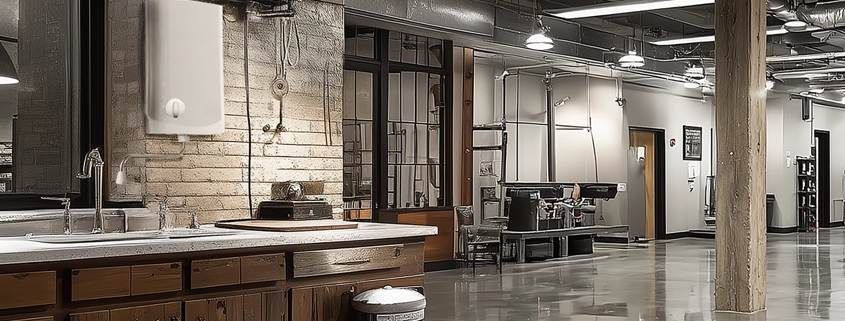Point-of-use (POU) electric water heating in commercial applications was designed for single-outlet demands, usually located far from the plant room, which would be difficult to supply in other ways. Typical examples of its application might be an outbuilding, small buildings with low hot water demand, a tea point in a warehouse with few employees or a small washroom at the end of a long, dead-end corridor.
Increasingly, POU is being specified in buildings without a gas connection to decentralise the hot water system. But is this the right way to use the technology?
Centralised hot water systems have been in use in commercial buildings for generations, where the pumped secondary returns ensure hot water is available at the tap quickly. But, secondary pipework does lose energy, and this is presented as an argument for using POU, but is this just increasing complications and costs?
We also need to recognise how centralised systems work and understand if all energy loss is a waste or a necessary function of the system. And, if eradicating energy losses, will it improve the system? The answer is not as straightforward as you might think.
Under BS 5422:2023, the minimum level thickness of insulation is established for non-domestic hot water service areas to control heat loss (25-40mm for 17 to 60mm external diameter pipework). Under this regulation, where an average of 9W/m maximum heat loss is permissible, secondary losses from centralised systems meet acceptable levels.
Under this current condition, if we were to apply the maximum permissible heat loss to a 50m run of secondary return pipework, operating for 16 hours per day, the secondary losses would amount to 7.2 kWh/day. POU aims to replace the centralised system and eliminate this secondary loss. As a conservative response, we could propose a replacement POU application employing 10 x 15-litre over- or under-sink units. However, you must remember that POU also exhibit standing losses, which can easily be 0.85 kWh/day. Multiply this by the specified 10 units, and losses from POU will equate to 8.5 kWh/day. These are averages, so there will be variance. Overall, the energy losses of both systems are going to be similar.
If energy losses are part of both centralised and POU-based systems, and are acceptable within the specification, what are the other considerations?
Let’s take school buildings as an example, where the Department for Education (DfE) currently recommends a variety of approaches to water heating, with centralised systems for catering functions which represent a large, single ‘point of use’ of hot water. In addition, “design and installation shall prioritise the use of local non-storage (or low storage) ‘point of use’ electric water heaters. This is to reduce standing losses from centralised systems and to prevent pipework heat loss, increasing the risk of overheating.”
This approach is driving the specification of heat pumps to support the ‘centralised’ kitchen and then large numbers of POU electric water heaters. A recent example of a primary school with 350 students intended to incorporate more than 35 POU heaters for washbasins located throughout the school.
Although units are individually low-cost, at these numbers, the capital investment starts to climb, especially when factoring in the high cost of cabling in each unit. POU electric water heaters are also basic, with no connection to the Building Management System (BMS), so there is no option to highlight a fault, enable the unit or apply time control. That’s compounded by a lack of individual miniature circuit breakers (MCBs) to prevent damage or potential fire from an overload or short circuit. Crucially for water heating, which is a business-critical service, there is no redundancy with a POU water heater. If it breaks, there is no hot water at the tap until it is repaired or replaced.
Regular maintenance of hot water systems is a critical part of efficient operation, with regular replacement of anodes and descaling of tanks where high-intensity temperatures created by electric immersions encourage the formation of limescale. This is wet, dirty work that, in centralised systems, is contained within the plant room. While the issues of limescale can be virtually eliminated in centralised systems such as Adveco’s award-winning FUSION package electric water heating systems, POU water heaters cannot avoid it in hard water areas and will exhibit scale problems with some variance in time due to the intensity of use. The problem is that building operators do not maintain point-of-use water heaters, so maintenance or, more likely, replacement will be necessitated as the cost of a new unit at £150 does not warrant a £100 maintenance charge.
For this reason, POU systems will be subject to a rolling replacement program, which will subsequently increase a building’s embodied carbon and landfill waste generation. This also brings maintenance personnel into the occupant’s space. Professional offices do not want technicians working in their toilets, whilst many buildings, such as schools, care homes, prisons, or hospitals, have safeguarding concerns with technicians in occupied spaces, who are then carrying out wet, messy work.
With the drive to eradicate energy losses not stacking up, as POU standing losses are likely to equal or even supersede secondary losses of well-designed centralised systems, most commercial buildings should have a centralised hot water system with secondary return and not POU on every floor of shell and core constructed properties. The centralised system is also able to take advantage of low-carbon preheat, whether in the form of heat pumps or solar thermal, that can continue to evolve the system’s ability to reduce dependency on energy, reducing carbon emissions and energy costs across its lifetime. On paper, POU electric water heaters appear to be a quick and easy way to distribute hot water throughout a building. But the reality is that throughout the operational life of the building, POU is, unless correctly employed as a terminal fixture away from the centralised system, ultimately expensive, problematic and limited in options for future developments.
















